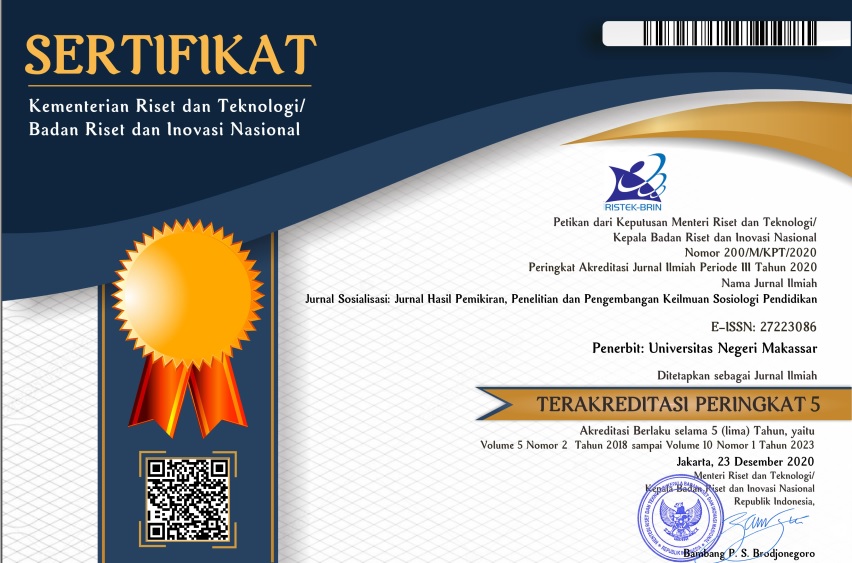PERUBAHAN GAYA HIDUP MAHASISWA JURUSAN SOSIOLOGI UNIVERSITAS NEGERI MALANG DENGAN HADIRNYA BUDAYA POPULER JEPANG
(1) The State University of Malang
(2) The State University of Malang
(3) The State University of Malang
(4) The State University of Malang
(5) The State University of Malang
(*) Corresponding Author
DOI: https://doi.org/10.26858/sosialisasi.v1i1.27298
Abstract
Keywords
Full Text:
PDFReferences
Afiuddin, M. C. (2019). Fenomena Gaya Hidup Remaja Wibu Pada Budaya Populer Jepang Melalui Anime Dan Fashion (Studi Di Daerah Daan Mogot Cengkareng Jakarta Barat). Ilmu Sosial Dan Politik, 5(2), 40–51.
Aisyah, I. (2019). ( Studi pada Mahasiswa yang Tergabung dalam Komunitas Japan Freak UIN Jakarta ) Skripsi Untuk Memenuhi Salah Satu Syarat Gelar Sarjana Pendidikan ( S . Pd ).
Amalina, A. (2015). Budaya Populer Jepang Sebagai Instrumen Diplomasi Jepang dan Pengaruhnya Terhadap Komunitas-Komunitas di Indonesia. Andalas Journal of International Studies (AJIS), 1(2). https://doi.org/10.25077/ajis.1.2.108-122.2012
Atus, S. (2011). Kelompok Penggemar Manga Online ( Online Manga Fandom ).
Budianto, F. (2015). Tinjauan Buku Anime, Cool Japan, Dan Globalisasi Budaya Populer Jepang. Jurnal Kajian Wilayah, 6 No.2.
Erwindo, C. W. (2018). Efektifitas Diplomasi Budaya Dalam Penyebaran Anime Dan Manga Sebagai Nation Branding Jepang. Jurnal Analisis Hubungan Internasional, 7(2).
Gunawan, I., 2013. Metode penelitian kualitatif. Jakarta: Bumi Aksara, 143.
HAEKAL, D. M. (2018). PENGARUH PERKEMBANGAN BUDAYA ANIME JEPANG TERHADAP PERUBAHAN PERILAKU KAUM REMAJA DI KOTA BANDUNG (Doctoral dissertation, PERPUSTAKAAN).
Hoeran, Adzni. 2017. “ِPengaruh Budaya Populer Manga Dan Anime Jepang Terhadap Apresiasi Masyarakat Muda Indonesia”.” Penerapan Embellishment Sebagai Unsur Dekoratif Pada Busana Modestwear d(2017).
Imami, V. C. Al. (2017). Pengaruh Tayangan Naruto Di Global Tv Terhadap Perilaku Siswa-Siswi Sdn Panjang Jiwo 1 Surabaya. https://eprints.stikosa-aws.ac.id/107/
M Arrum, Arroisi. (2016). PERSEPSI REMAJA USIA 12-15 TAHUN TERHADAP KEKERASAN DALAM ANIME NARUTO DI SMP 47 DAN SMP DIPONEGORO JAKARTA. PhD Thesis. Universitas Darma Persada
Novera, Clara. 2017. “Manga Dan Anime Sebagai Budaya Populer Jepang.” Thesis (April 2017).
Nugroho, Prista Ardi, and Grendi Hendrarastomo. 2017. “Anime Sebagai Budaya Populer (Studi Pada Komunitas Anime Di Yogyakarta).” Jurnal Pendidikan Sosiologi 6(3).
Prasetyo, Kuncoro Adhi, Fakultas Ilmu, Pengetahuan Dan, and Program Studi Jepang. 2014. “Pengaruh Anime, Kuncoro Adhi Prasetyo, FIB UI, 2014.” Makalah non-seminar.
Puspitasari, G., & Khasanah, U. (2019). PERSEPSI TERHADAP TOKOH WANITA DALAM ANIME 2D MENURUT PARA PECINTA ANIME DI INDONESIA. Mezurashii, 1(2). https://doi.org/10.30996/mezurashii.v1i2.3238
Sokalia Anjani, P., & Puri Astiti, D. (2020). Hubungan kontrol diri dan konformitas terhadap perilaku konsumtif remaja penggemar animasi Jepang (anime) di Denpasar. Jurnal Psikologi Udayana, 1, 144–155. https://ojs.unud.ac.id/index.php/psikologi/article/view/57813
Sukarman, M. M. H. (2021). Fanatisme otaku terhadap anime one piece (studi kasus pada komunitas nakama istimewa Yogyakarta). Skripsi. Yogyakarta: Fakultas Psikologi Dan Ilmu Sosial Budaya Universitas Islam Indonesia.
Article Metrics
Abstract view : 763 times | PDF view : 238 timesRefbacks
- There are currently no refbacks.

This work is licensed under a Creative Commons Attribution 4.0 International License.


































